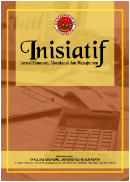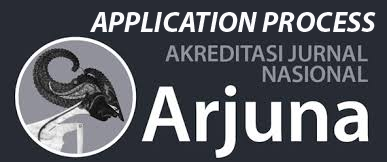Strategi Pengembangan Produk Baitut Tamwil Muhammadiyah (BTM) dalam Meningkatkan Keunggulan Bersaing
(Pada KSPPS BTM Sumatera Barat Cabang Sungai Rumbai)
DOI:
https://doi.org/10.30640/inisiatif.v3i4.3038Keywords:
Product Development Strategy, Bitut Tamwil, Competitive AdvantageAbstract
This research aims to formulate a product development strategy that will be carried out by KSPPS BTM West Sumatra Sungai Rumbai Branch in increasing its competitive advantage. The research method used is field research using qualitative descriptive methods. Research data collection techniques are documentation, interviews and observation. The data analysis method used is SWOT analysis which uses IFE, EFE analysis, SWOT matrix, and score weight table analysis to identify and analyze factors. From the research results, the Baitul Tamwil Muhammadiyah (BTM) product development strategy at KSPPS BTM West Sumatra Sungai Rumbai Branch has an IFE matrix analysis that produces an overall score of 3.5, which means taking advantage of the advantages of the BTM cooperative and maximizing internal factors, this has been achieved. EFE matrix analysis produces an overall score of 3.15 which shows that the BTM cooperative is very responsive to external factors by taking advantage of existing opportunities. The weighted score of the SO strategy is 3.9, the WO strategy is 3.2, the ST strategy is 3.45, and the WT strategy is 2.75. Based on the weighted assessment, the SO strategy score has the highest points compared to other strategies. The weighted evaluation is based on the contribution of the strengths or weaknesses to the achievement of the company's goals, vision and mission. The higher the weight, the greater the contribution and influence on achieving the company's goals, vision and mission, where the Strength Opportunities (SO) assessment can be used as a strategy to capture and utilize strengths in order to seize as many opportunities as possible from competitors.
References
Anggraini, R. D. (2015). Metode perumusan strategi perusahaan asuransi untuk pencapaian target perusahaan. Jurnal Teknik Industri, 5(3), 15.
Asriyal, A. M. (2023, December 4). Wawancara pribadi di KSPPS BTM Sumatera Barat Cabang Sungai Rumbai [Personal interview].
Dasopang, N. (2022). BMT sebagai lembaga keuangan syariah. Jurnal Islamic Circle, 3(2), 70-72.
David, F. R. (2011). Manajemen strategi: Konsep (pp. 23-25). Jakarta: Salemba Empat.
Djazuli, A., & Janwari, Y. (2002). Lembaga-lembaga perekonomian umat: Sebuah pengenalan. Jakarta: PT Raja Grafindo.
Erline, T. V. T., dkk. (2021). Strategi camat dalam meningkatkan perangkat desa di bidang teknologi informasi di Kecamatan Ratahan Timur Kabupaten Minahasa Tenggara. Jurnal Governance, 1(2), 3.
Huda, N., & Heykal, M. (2010). Lembaga keuangan Islam: Tinjauan teoritis dan praktis. Jakarta: Kencana.
Ida, R. (2018). Etnografi virtual sebagai teknik pengumpulan data dan metode penelitian. The Journal of Society and Media, 2(2), 118.
Lubis, S. K., & Wajdi, F. (2012). Hukum ekonomi Islam. Jakarta: Sinar Grafika.
Mubayyin, A., & Abdullah, W. (2021). Implementasi manajemen keuangan syariah sebagai salah satu upaya untuk memajukan dan mengembangkan UMKM di Indonesia. JES (Jurnal Ekonomi Syariah), 6(1).
Nawawi, H. (2012). Metode penelitian bidang sosial. Yogyakarta: Gadjah Mada University Press.
Nur, I., dkk. (2022). Efektivitas strategi fundraising berbasis online. Jurnal Ekonomi Islam Makassar, 2(1), 59.
Parrangan, E. R., dkk. (2015). Analisis strategi perusahaan dalam ekspansi pasar luar negeri. Jurnal Administrasi Bisnis, 26(2), 3.
Porter, M. E. (2000). Strategi bersaing: Teknik menganalisis industri dan pesaing (A. Maulana, Trans.). Yogyakarta: Liberty.
Purnomo, B. H. (2011). Metode dan teknik pengumpulan data dalam penelitian tindakan kelas (classroom action research). Jurnal Pengembangan Pendidikan, 8(1), 210.
Raymundus, I. W. R. (2018). Perencanaan manajemen strategi dan kepuasan kerja terhadap kinerja pegawai. Business Management Jurnal, 14(2), 75.
Rukajat, A. (2018). Pendekatan penelitian kualitatif (qualitative research approach). [Booklet].
Saad, M., dkk. (2020). Strategi pemasaran usaha pembelian ikan laut dengan metode matriks BCG dan SWOT di CV. Jioen Fishery di Desa Wedung, Kecamatan Brondong, Kabupaten Lamongan. Jurnal Grouper, 11(2), 18-26.
Siyoto, S., & Sodik, M. A. (2015). Dasar metodologi penelitian. Literasi Media Publishing.
Suyanto, B., dkk. (2011). Metode penelitian sosial. Jakarta: Kencana Prenada Media Group.
Yatminiwati, M. (2019). Manajemen strategi: Buku ajar perkuliahan bagi mahasiswa. Jawa Timur: Penerbit Widya Gama Press.
Downloads
Published
How to Cite
Issue
Section
License
Copyright (c) 2024 Inisiatif: Jurnal Ekonomi, Akuntansi dan Manajemen

This work is licensed under a Creative Commons Attribution-ShareAlike 4.0 International License.








